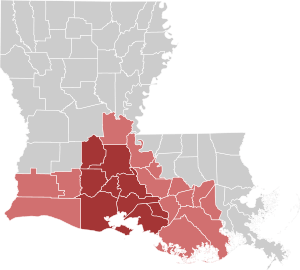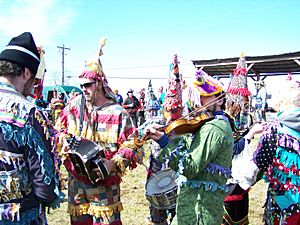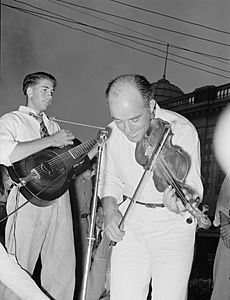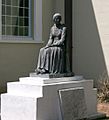Cajuns facts for kids
 |
|
| Total population | |
|---|---|
| 1.2 million (2002 estimate) | |
| Regions with significant populations | |
| 815,259 | |
| 546,354 | |
| Languages | |
| French (Louisiana French) English (Cajun English) Louisiana Creole |
|
| Religion | |
| Christianity: Predominantly Roman Catholicism | |
| Related ethnic groups | |
| Acadians, Métis, Atakapa, Choctaw, Chitimacha, French, French Americans, French Canadians, Spaniards, Isleño, Spanish Americans, Québécois, Louisiana Creoles, French Haitians | |
The Cajuns are an ethnic group mainly living in the U.S. state of Louisiana, and in the Canadian maritimes provinces as well as Quebec consisting in part of the descendants of the original Acadian exiles—French-speakers from Acadia (L'Acadie) in what are now the Maritimes of Eastern Canada. In Louisiana, Acadian and Cajun are often used as broad cultural terms without reference to actual descent from the deported Acadians. Historically, Louisianians of Acadian descent were also considered to be Louisiana Creoles, although Cajun and Creole are often portrayed as separate identities today. The Cajuns make up a significant portion of south Louisiana's population and have had an enormous impact on the state's culture.
While Lower Louisiana had been settled by French colonists since the late 17th century, the Cajuns trace their roots to the influx of Acadian settlers after the Great Expulsion from their homeland during the French and British hostilities prior to the Seven Years' War (1756 to 1763). The Acadia region to which modern Cajuns trace their origin consisted largely of what are now Nova Scotia, New Brunswick, Prince Edward Island plus parts of eastern Quebec and northern Maine. Since their establishment in Louisiana, the Cajuns have become famous for their unique French dialect, Louisiana French (also called "Cajun French," although the dialect predates the Acadians' arrival in Louisiana), and have developed a vibrant culture including folkways, music, and cuisine. The Acadiana region is heavily associated with them.
Contents
Culture
Geography
Geography had a strong correlation to Cajun lifestyles. Most Cajuns resided in Acadiana, where their descendants are still predominant. Cajun populations today are found also in the area southwest of New Orleans and scattered in areas adjacent to the French Louisiana region, such as to the north in Alexandria, Louisiana. Strong Cajun roots, influence, and culture can also be found in parts of Southern Mississippi. These areas include Bay St. Louis, Pass Christian, Gulfport, Gautier, Natchez, D'Iberville, and Biloxi, Mississippi. Over the years, many Cajuns and Creoles also migrated to the Houston, Beaumont and Port Arthur areas of Southeast Texas, in especially large numbers as they followed oil-related jobs in the 1970s and 1980s, when oil companies moved jobs from Louisiana to Texas. However, the city of Lafayette is referred to as "The Heart of Acadiana" because of its location, and it is a major center of Cajun culture.
Music
Cajun music is evolved from its roots in the music of the French-speaking Catholics of Canada. In earlier years, the fiddle was the predominant instrument, but gradually the accordion has come to share the limelight. Cajun music gained national attention in 2007, when the Grammy Award for Best Zydeco or Cajun Music Album category was created.
Cuisine
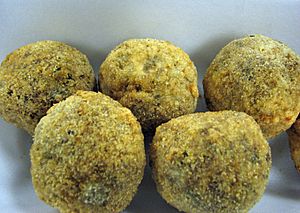
Due to Le Grand Dérangement, many Acadians were invited to settle in Louisiana by the Spanish Governor Galvez. Unfamiliar with the terrain, they assimilated Creole and Native American influences into their Acadian traditions. Cajun cuisine focused on local ingredients and wild game (e.g., duck, rabbit), vegetables (e.g., okra, mirlitons), and grains. Coastal communities relied heavily on fish and shellfish. Seafood, especially shellfish, is still very popular in the region and remains a dominant feature of many classic Cajun dishes like seafood gumbo and court boullion.
Since many Cajuns were farmers and not especially wealthy, they were known for not wasting any part of a butchered animal. Many rural communities held a weekly boucherie, which is a communal butchering of an animal, often a pig. Each family received a share of the meat. Some high-profile foods like cracklins and boudin are examples of Cajun cuisine that are widely popular.
Language
Cajun French is a misnomer for the French that was spoken before the Acadians arrived. It is a variety or dialect of the French language spoken primarily in Louisiana. At one time as many as seven dialects were spread across the Cajun heartland.
Recent documentation has been made of Cajun English, a French-influenced dialect of English spoken by Cajuns, either as a second language, in the case of the older members of the community, or as a first language by younger Cajuns.
Religious traditions
"Our Lady of the Assumption" is Patroness of the Acadians (Cajuns). In 1638, the colonies of France, to include Acadie, and France were consecrated by the Pope and the King to Mary under the aforementioned title; the date of consecration was August 15 which is the Solemnity of the Assumption of the Blessed Virgin Mary and is a Holy Day of Obligation for Roman Catholics (Source 4).
Traditional Catholic religious observances such as Mardi Gras, Lent, and Holy Week are integral to many Cajun communities. Likewise, these traditional Catholic religious observances may further be understood from Cultural Catholicism in Cajun-Creole Louisiana by Marcia Gaudet which tells that such traditional religious observances, although they may not be "strictly theological and liturgical forms", are still integral and necessary to many and remain religiously valid as "unofficial religious customs and traditions are certainly a part of Roman Catholicism as it is practiced".
Mardi Gras
Mardi Gras (French for "Fat Tuesday", also known as Shrove Tuesday) is the day before Ash Wednesday, which marks the beginning of Lent, a 40-day period of fasting and reflection in preparation for Easter Sunday. Mardi Gras was historically a time to use up the foods that were not to be used during Lent, including fat, eggs, and meat.
Mardi Gras celebrations in rural Acadiana are distinct from the more widely known celebrations in New Orleans and other metropolitan areas. A distinct feature of the Cajun celebration centers on the Courir de Mardi Gras (translated: fat Tuesday run). A group of people, usually on horseback and wearing capuchons (a cone-shaped ceremonial hat) and traditional costumes, approach a farmhouse and ask for something for the community gumbo pot. Often, the farmer or his wife allows the riders to have a chicken, if they can catch it. The group then puts on a show, comically attempting to catch the chicken set out in a large open area. Songs are sung, jokes are told, and skits are acted out. When the chicken is caught, it is added to the pot at the end of the day. The courir held in the small town of Mamou has become well known. This tradition has much in common with the observance of La Chandeleur, or Candlemas (February 2), by Acadians in Nova Scotia.
Easter
On Pâques (French for Easter), a game called pâquer, or pâque-pâque was played. Contestants selected hard-boiled eggs, paired off, and tapped the eggs together – the player whose egg did not crack was declared the winner. This is an old European tradition that has survived in Acadia until today. Today, Easter is still celebrated by Cajuns with the traditional game of paque, but is now also celebrated in the same fashion as Christians throughout the United States with candy-filled baskets, "Easter bunny" stories, dyed eggs, and Easter egg hunts.
Folk beliefs
One folk custom is belief in a traiteur, or healer, whose primary method of treatment involves the laying on of hands and of prayers. An important part of this folk religion, the traiteur combines Catholic prayer and medicinal remedies to treat a variety of ailments, including earaches, toothaches, warts, tumors, angina, and bleeding. Another is in the rougarou, a version of a loup garou (French for werewolf), that will hunt down and kill Catholics who do not follow the rules of Lent. In some communities, the loup garou of legend has taken on an almost protective role. Children are warned that loups garous can read souls, and that they only hunt and kill evil men and women and misbehaved horses.
Celebrations and gatherings
Cajuns, along with other Cajun Country residents, have a reputation for a joie de vivre (French for "joy of living"), in which hard work is appreciated as much as "let the good times roll / laissez les bon temps rouler".
Community gatherings
In the culture, a coup de main (French for "to give a hand") is an occasion when the community gathers to assist one of their members with time-consuming or arduous tasks. Examples might include a barn raising, harvests, or assistance for the elderly or sick.
Festivals
The majority of Cajun festivals include a fais do-do ("go to sleep" in French, originating from encouraging children to fall asleep in the rafters of the dance hall as the parents danced late into the night) or street dance, usually to a live local band. Crowds at these festivals can range from a few hundred to more than 100,000.
Images for kids
-
The Acadian Country in 1754
-
Acadian militia captain Joseph "Beausoleil" Broussard
-
The deportation of the Acadians.
-
Filipino-Cajuns of Saint Malo, Louisiana
-
Singer Beyoncé is of Cajun Creole heritage
-
Louisiana's Cajun governor, Edwin Edwards
-
A statue of Evangeline—fictional heroine of the poem Evangeline by Longfellow—at St. Martinville, Louisiana. The statue was donated by actress Dolores del Río, who also posed for it. In a 1929 silent film by director Edwin Carewe, del Rio portrayed Evangeline.
See also
 In Spanish: Cajún para niños
In Spanish: Cajún para niños


